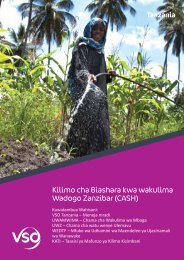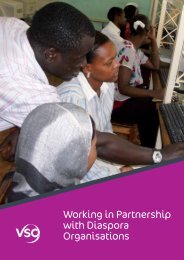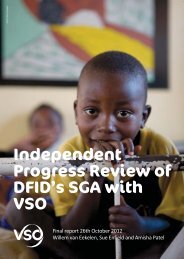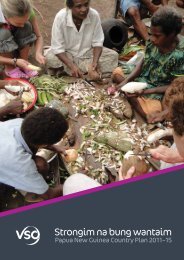Our Side of the Story - VSO
Our Side of the Story - VSO
Our Side of the Story - VSO
- No tags were found...
You also want an ePaper? Increase the reach of your titles
YUMPU automatically turns print PDFs into web optimized ePapers that Google loves.
<strong>Our</strong> <strong>Side</strong> <strong>of</strong> <strong>the</strong> <strong>Story</strong>: The lived experience and opinions <strong>of</strong> Ugandan health workersHealth and human rights training• Expand existing partnerships between training institutionsand health consumer advocacy organisations. Improvenursing course content to make sure that students takeon board <strong>the</strong> role <strong>of</strong> <strong>the</strong> nurse as a patient’s advocate.De-urbanise health worker training• Increase <strong>the</strong> number <strong>of</strong> training schools and residencyprogrammes in rural areas to produce staff already adaptedto rural environments and connected to <strong>the</strong> local community.• Improve <strong>the</strong> community service element in medical curriculaand increase <strong>the</strong> exposure <strong>of</strong> urban health students to ruralsettings with increased fieldwork.Nurses and Midwives Council registration interviews• The Nurses and Midwives Council should weigh up <strong>the</strong>advantages <strong>of</strong> screening interviews held as a prerequisitefor registration post-qualification against detrimentaleffects on nurse morale.2. Raise <strong>the</strong> voices <strong>of</strong> health workersSharing <strong>of</strong> experience and common approaches• Encourage staff to meet with people from o<strong>the</strong>r healthcarefacilities to discuss solutions to common problems andcommunicate <strong>the</strong>m to sub-district level managers. Thesemanagers could also be encouraged to instigate similar forums.Speaking through pr<strong>of</strong>essional associations, unions andregulatory councils• Channel health worker concerns to <strong>the</strong> Ministry <strong>of</strong> Health,Government or Parliament through bodies that speak for<strong>the</strong>m, such as pr<strong>of</strong>essional organisations and trade unions.• Pr<strong>of</strong>essional associations and unions should do more to bringmembers toge<strong>the</strong>r, for instance at local general meetings,and make greater efforts to visit facilities and talk with healthworkers so that <strong>the</strong> “right voices” can be taken to <strong>the</strong> top.They should compile strong collective arguments to improveconditions in <strong>the</strong> workplace, as well as addressing individualgrievances and traditional welfare issues.• The Health Workforce Advocacy Forum – Uganda (a coalition<strong>of</strong> health pr<strong>of</strong>essional associations, unions and health rightsorganisations) should expand its membership and continue itscampaign for a positive practice environment for health workers.3. Change public perceptions by influencing <strong>the</strong> media• Inform journalists about <strong>the</strong> obstacles to health workerrecruitment and discourage <strong>the</strong>m from writing sensationalistor negative stories in <strong>the</strong> media. Put complaints on locallanguage radio call-in shows into a wider context. Encourage<strong>the</strong> running <strong>of</strong> positive human interest features, such aspr<strong>of</strong>iles <strong>of</strong> individual health workers and <strong>the</strong> work <strong>the</strong>y do.Work with <strong>the</strong> Uganda Health Communication Alliance.• Improve <strong>the</strong> capacity <strong>of</strong> civil society and health workerorganisations to write press releases, hold press conferencesand build relationships with individual reporters and mediahouses, so <strong>the</strong> key campaign messages hit home.4. Build bridges between patient communities,healthcare facilities and staffTransparency on drug availability• Use well-managed public opening <strong>of</strong> medicine deliveries tohelp convince communities that medicines are not in stock,and to counter accusations <strong>of</strong> <strong>the</strong>ft. Call on local notables,police or patients to witness <strong>the</strong> opening <strong>of</strong> boxes. Supportwith paperwork to show what has been ordered and delivered.• Ensure that local leaders are fully informed through regularmeetings about <strong>the</strong> demand for and supply <strong>of</strong> drugs and that<strong>the</strong>y use this information responsibly.Connecting communities and facilities• Use opportunities to talk with people on <strong>the</strong>ir own groundand explain <strong>the</strong> problems health workers face, for instancethrough Village Health Teams, facility-based health workersproviding outreach immunisation services, and talks towomen awaiting prenatal checks.• Promote ‘community dialogue’ meetings bringing toge<strong>the</strong>rservice users, local leaders and health unit managementteams. Increase funds to cover <strong>the</strong>se activities.• Invite top local politicians to spend time in facilities alongsidestaff to see what <strong>the</strong> work is really like.• Civil society organisations should continue <strong>the</strong>ir work tocreate common cause between health workers and patients.11
















